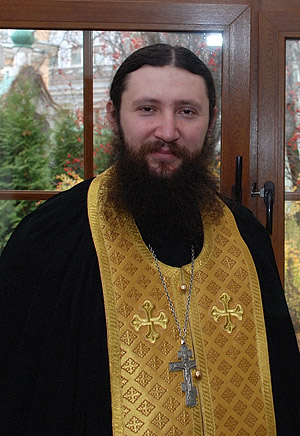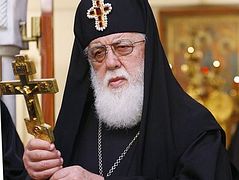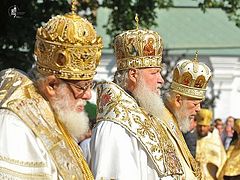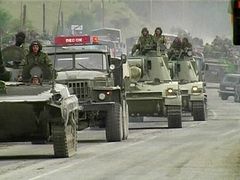 Hieromonk Nicodim (Bekenev). <br>Foto: A.Pospelov / Pravoslavie.Ru – Fr. Nicodim, tell us a little about yourself, about how you came to the monastery.
Hieromonk Nicodim (Bekenev). <br>Foto: A.Pospelov / Pravoslavie.Ru – Fr. Nicodim, tell us a little about yourself, about how you came to the monastery.
– I was born and raised in Moscow. I was baptized at age ten, and consider myself to be a believer from that age. I owe my involvement in Church life to my parents, first of all to my stepfather. After high school I entered the 1905 Moscow Academy of Arts. I grew up like most Moscow boys—I played sports, wrestled, was a student, went out with my friends. In my youth, during my studies, I got a little distanced from church life. But toward the end of my studies my faith was re-lit and burned with new strength, and within a few months after graduation, I “fled” the world and joined the monastery.
– Although you lived in Moscow, did you keep up your contacts with the Ossetian diaspora, or with South Ossetia?
– I have relatives and friends living in South Ossetia. During the soviet years, my stepfather worked as the chief director of the South Ossetian Theatre of Drama. Naturally, his friends and colleagues were constant guests in our home, and so I actually grew up in an Ossetian milieu. Of course, I often saw my friends in South Ossetia—practically all of whom are Orthodox—and I still see them.
– As a priest, you visit South Ossetia, which is under the jurisdiction of the Georgian Patriarchate. Have you had the occasion to get a blessing from the ruling hierarch of the Georgian Orthodox Church during your pastoral visits to South Ossetia?
– Yes. At the beginning of 2008 I went there to baptize my relative in South Ossetia. The situation was tense even then, but it was still possible to cross the border into Georgia. A monk of our monastery, Hierodeacon Nathaniel (Muraloshvili), was in Tbilisi at the moment visiting his parents. It was his birthday, and we agreed to meet at the border. He came to meet me with Igumen John (Abasoshvili), a priest of the Georgian Church. Fr. Nathaniel wanted to invite me to Tbilisi, to introduce me to his parents. He went to the local hierarch, Archbishop Isaiah, to ask for his assistance in getting across the border. Vladyka helped us, and naturally when I got to Georgia I went to the Archbishop to thank him for his help. I also asked his blessing at that time to serve the sacraments.
– Is there anything in particular that you could note about the local Church practices of that region? Has Orthodox spiritual tradition been preserved through the atheistic soviet period, after the persecutions against the Church?
– Ossetians are an ancient Orthodox nation, the descendents of the Alans, who received Orthodoxy from Byzantium in the tenth century. There are also known Alan saints who suffered also in the second century. In the Alan nation, Orthodoxy was the state religion. In the register of the Constantinople Patriarchate, the Alan Metropolia occupied the 61st place, right after Kiev. The end of the fourteenth century was catastrophic for the Alans; they were almost entirely wiped out while fighting for their faith with the armies of Tamerlane. Only a very small remnant was left, which the enemy was unable to destroy, and they are what are now the modern Ossetians (one of the ancient names for the Alans is Ovs, or Yas). Every Ossetian soaks up the ideas of God, the saints, prayer, etc., from the time he is born, through the traditions preserved by his ancestors.
Every Ossetian holiday, or any important event, begins with prayers to God and the saints. Ossetians consider St. George the Great Martyr (Uastyrdzhi) their patron saint, and always invoke his help, protection, and support for each other. There are many ancient Christian sites on the territory of Ossetia, both North and South. Although many of them have not survived to our times, people remember these places, and celebrate the memory of the saints or Christian events to which these churches or chapels were dedicated. In the South, many of these structures are crumbling before our very eyes, because there is no money to restore them. In some villages people are building new churches with their own hands to replace the lost ones. A few decades earlier it would have been possible to preserve many monuments of Christianity—the churches and frescoes themselves. But even now, there are many historical sites which witness to the Christian labors of ancient ascetics.
Some people cannot understand what Ossetians are worshipping when they go to pray in wooded areas or on hills. Some even think that they are worshipping stones or trees, but in fact these are places where ancient churches once stood. Places where altars were destroyed are particularly marked, and out of veneration for a holy place, people are careful not to disturb the peace there, or to tread upon it.
Almost all Ossetian holidays have ancient Christian roots. Before the October revolution, Tsarist Russia and Church authorities understood the significance of Christianity for Ossetians. Holy Scripture was translated into the Ossetian language, and in North Ossetia, the Divine Services were celebrated for the people in their native language.
As opposed to the North, Divine Services were not celebrated in South Ossetia under the soviet regime, although several churches were preserved in Tsinkvali itself and in surrounding villages. The end of soviet rule was the beginning of the conflict with Georgia. In 1989, Georgia was already talking at the government level about leaving the Soviet Union, and about Russia as enemy number one, while the South Ossetian Autonomous Republic expressed its desire to remain a part of the Soviet Union, and pronounced itself an independent republic. Troubled times began, and ethnic Ossetians were subjected to persecutions and injury; tens of thousands of people were forced to flee Georgia for Russia because of persecution of Ossetian nationality, and resulting robbery and murder. The ancient Ossetian villages of Gori and other regions of Georgia became vacant. Nearly the entire territory was overtaken by war, resulting in the death and injury of thousands of peaceful inhabitants.
The Georgian Church considered, and still considers Ossetia its canonical territory. Just the same, the Georgian Church has not made any serious attempts to pastor the South Ossetian flock. A non-canonical Church sprang up, and is still active there.
– You were already a hieromonk when the military conflict arose in 2008. How did you receive this news about the conflict between two Orthodox peoples?
– As a personal tragedy.
– How soon after the conflict did you go to South Ossetia? What inwardly motivated you to go there?
– On the night of October 7, 2008, I heard about the artillery attack upon the city. I tried to get in contact with my friends and relatives, and by the next evening I was on the road. I was in the car all day on the October 9, and on the following day, I was in Southern Ossetia. My inner motivation in such a situation, I think, is understandable to anyone.
– Tell us your impressions of what you saw there. Did faith and prayer help the Orthodox Ossetians to overcome their anguish, or a desire for revenge against the Georgian government, who helped set this fratricidal conflict in motion?
– Neither the war of 1991–92, nor the escalation of the conflict in 2004 wrought such massive destruction as the conflict of August, 2008. It was a horrific sight! Communication was bad. Even while I was still on the road, I heard that many of my acquaintances had perished, because they couldn’t be reached. Fortunately, many of these communications turned out to be wrong, but not all of them... The atmosphere of panic and oppression was replaced by hope that the military actions would soon be over. The city was destroyed, and was burning. In the city itself, the dead were buried in gardens and yards of houses; outside the city there were many dead, and the smell of corpses was everywhere.
People were forced to go through very much, especially those who hid in basements while the Georgian soldiers were “purging.” They threw hand grenades into those basements were they suspected people were hiding. Many had to witness people being shot or burned, and cars being crushed by tanks. There were cars carrying women and children who tried to escape the city along the Zara road. My friends who served in the Ossetian peace-keeping battalions extracted with their own hands the burned bodies of children from burning cars.
– In your opinion, is the Georgian Orthodox Church capable at the present moment of providing pastoral care to the Orthodox flock in South Ossetia?
– In my opinion, and I think that I share this opinion with most South Ossetians, they are not capable right now. I have heard from Georgians the opinion that a Georgian priest would not be allowed to come into South Ossetia. Now it is that way. But it seems to me that such an opinion would have been groundless earlier, because there were, and still are, ethnic Georgians living in Tsinkvali, who were furthermore never repressed, and it would have been possible to come and serve for these people in the 1990’s. But no one ever made such an attempt. If just one Georgian priest were to suffer together with his flock through the difficulties, depravations, and artillery fire, and would have prayed for them in the besieged city, people would know that the Church is above politics. But they were not there. In their place were people with the courage and love needed for their people, but these were members of an uncanonical group. That is a tragedy! As for the canonical jurisdiction, unfortunately we can only reiterate the grievous fact that it has lost the trust of the Ossetian people for many decades to come.
Of course I understand that a great deal of anger and pain has mounted on both sides. I think that this can be gleaned from my answers, although I have spoken sincerely. But believe me, with God’s help, I bear no evil against the Georgians. There is the pain of irreparable loss and the heaviness of an injustice committed. Will we, the Ossetians and the Georgians, be able to rise up to the spiritual stature to which Christ calls us? I think that this is the most important question that each of us faces. This is what we need to ask of God in prayer.
– In your opinion, what role could the Russian Orthodox Church, or other Orthodox Churches, play in healing this terrible political, and to some extent, ecclesiastical conflict?
– I would like the Russian Orthodox Church and the Georgian Orthodox Church to not be indifferent to the fate of an Orthodox people. How this will happen is not for me to judge. Ossetians in their northern and southern homelands alike have historically bound their fate with Russia. This choice was made over 200 years ago. Ossetians were received by the Russian government as freemen, they were not vassals of another state, and they did not have a slavish mentality. When Empress Catherine [the Great] received them [as part of the Russian Empire], she likened them to Russian Cossackry. Therefore, they lived in the Russian Empire under the same conditions as the Cossacks—as freemen, and were obliged to provide soldiers to the Russian army, to participate in all the wars together with the Russians. All that time they upheld the conditions of the agreement as sacred, not once betraying Russia. During the revolutionary years, a large part of the Ossetians, like the Cossacks, remained faithful to the throne and their oath of allegiance, and it was the same during World War II—they were loyal to their country. Ossetians are an Orthodox nation, and they should be given the possibility to receive lawful spiritual care. The division of Ossetia into North and South may be geographical, but it is not political, and especially not spiritual. Ossetians are one nation.
– As an eyewitness, how do you assess the scale of moral and psychological disasters in South Ossetia?
– Such terrible events do not leave people unscathed. A generation of people has grown up without ever seeing a profitable, peaceful life. Nervous breakdowns, heart attacks... People die as a result of the war even months and years after it ends. Serious work is needed in order to overcome these consequences, and the role of the Church is very important in this.
– Does Sretensky Monastery, where you are a monk, aide the victims of the military conflict in South Ossetia?
– Just as in all the monasteries and churches of the Russian Orthodox Church, Sretensky Monastery collected donations for the victims during the Georgian attack.
– In your personal spiritual experience, what do you consider to be the most important thing for pastors to do in South Ossetia?
– Today South Ossetia is a fertile field for pastoral work. Most of the people who live there consider themselves Orthodox, and feel linked with Russia not just politically, but more importantly, spiritually. The gap which formed in Church life under the soviet regime is now disappearing. People are going to church, and there is a great thirst for the word of God. The holy fathers say that the most important conditions for salvation are memory of death and fear of God—and that is what people who live there have. Vain and worldly values have been relegated to a lower position.
Hieromonk Nicodim (Bekenev) was interviewed by Nun Cornelia (Rees)



